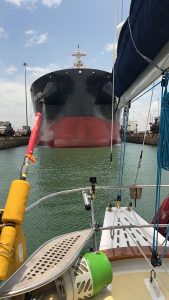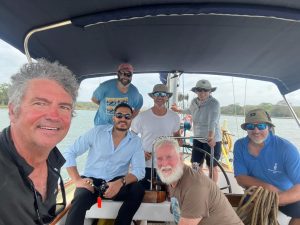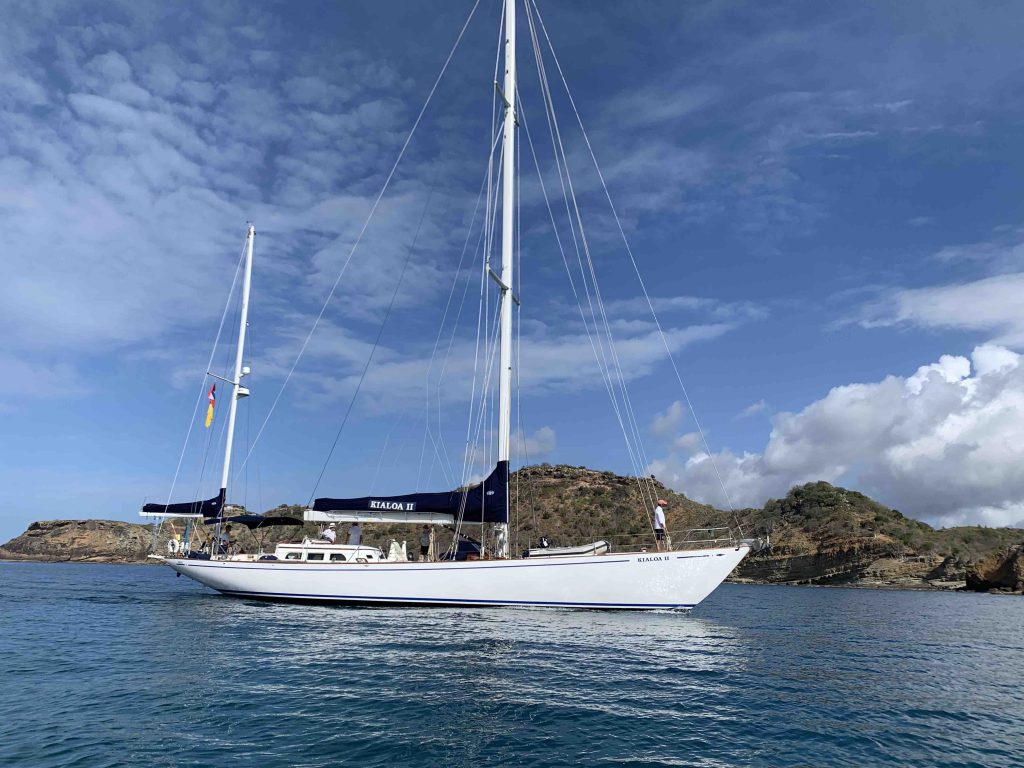23 Apr – (2300 GMT) Course 111 / Speed 5.7kts / Wind 245 4kts / DTG 55
Nice sail today with 7-9kts of breeze from 230-250, 4 sails up: jib, main, mizzen staysail and mizzen and rolling gently along at 7 kts. Effortless, even Audrey the autopilot seemed to be enjoying it. Where was this breeze when we could have used it? We’ve had to slow down this evening as there’s no point in arriving before 0800.
Anyway, a decent number of jobs done prior to getting in to Nelson’s Dockyard, English Harbour, tomorrow morning including fixing a leak in the floor of the dinghy (I’m going back to wooden floorboards, the blow up ones are too risky – get a leak and the whole dinghy is useless), fixed a blown fender – blown by the pilot boat during our canal transit while collecting the first and dropping off the second pilot, along with about a yard of varnish off the cap-rail, grrrr, you’d have thought they got enough practice.
Aired all the sails from the forepeak – and it’s a lot of sails as you can imagine given all the racing we’ve done. And used Scotty Major’s trick with the aluminium foil and water for getting rust spots off the stainless steel. Yes, scrunch up the foil, dip in water and rub on the rust spots. Works on chrome too. Amazing, so effective.
Night falling as we pass Nevis, pottering, looking forward to tomorrow.
22 Apr – (2300 GMT) Course 108 / Speed 6.8kts / Wind 250 8kts / DTG 208
A real glass out this morning. Not a common thing to see at sea. No wind ripples at all, just the ultra smooth swells rolling past. Eerie. After a night’s motor-sailing in helpful southerly biased breezes of 7-10 kts allowing us to head directly at Antigua, we’d covered good miles. So to the acid test: how much diesel had we used? This is where the day tank set up comes into its own. You may remember we have to pump fuel up from deep in the keel (where we hold about 1000 litres in 3 tanks) into a 100 litre day tank, set above the engine and generator. A bit of a pain sometimes, especially if the weather is rough and we’re rolling or pitching, it has its benefits. Because we have to actually transfer diesel up into it, we know exactly how much we are using. And the answer was a wonderfully frugal 4 litres an hour. Given we were travelling at around 7kts, thats good mileage. When the breeze dropped out we had to up the revs to get to a sensible cruising speed and so for the next 12 hours we’ve run at just under 5 litres and hour – still good, and yes plenty to get to Antigua with.
Happy day!
21 Apr – (2300 GMT) Course 106 / Speed 6.4kts / Wind 165 9kts / DTG 357
Woken from my off watch slumbers by the Santo Domingo port chatter from the commercial ships (when is my pilot due, I’m 8 miles from the anchorage, what time can I etc etc) on the VHF. Woken thinking “odd, I thought we were going to tack well before we’re in range of that”. Turns out we were closer inshore than expected, tack hadn’t happened, the boys couldn’t bear to give away a lift in the breeze I guess. No matter, still more than 10 miles offshore we tacked onto a nice lift in the breeze which carried us on port tack through the rest of the night from a heading of about 145 degrees to a respectable, almost-pointing-at-Antigua 115 degrees. That all had to be paid for, of course, so around 0800 we went into 90 minutes of squall games, numerous tacks, drenching rain, 20kt gusts and 120 degree shifts in the wind. Shaken but not stirred, after all that there was a bonus – a lift on starboard tack for the next 5 hours from 070 to an actually-pointing-at-Antigua 104. Bonus indeed.
However, and isn’t it always so, the predicted fade out in the trade winds has happened so we are now motor-sailing, breeze down to 7-9 kts from a still friendly 160 degrees, but the ugly seaway has yet to diminish in any significant way. At least yet, it will do, I’m sure.
And the great game begins: have we enough diesel to get to Antigua or will we need to wait for the wind to fill in next week? The clock is ticking, the motor is running.
20 Apr – (2300 GMT) Course 067 / Speed 6.6kts / Wind 110 14kts / DTG 486
A working to windward day. 6 tacks, a decent amount of current in our favour and breeze anything from 12-22 kts but mostly in the 14-18 range. The painful bit was the seaway, bumpy, chaotic, and covered in fields or blobs of sargassum seaweed. Amazing amounts of the stuff, a mustard colour, sometimes neatly arranged in long tramlines, curving away to windward, aligned with the wind, sometimes just in massive heaving blobs. Not so much of a problem to a hull shape like Kialoa, the fine stem, wine glass shape and long keel just shed the stuff sideways, but pity a boat with a fin keel and a bulb.
As we end our day we’re on starboard tack making our way towards the Dominican Republic shore about 80 miles away hoping the breeze holds out for 12-24 more hours. Forecast is for our last 2-3 days to be zero wind and motoring as a front crosses SE USA and sucks the life out of the Caribbean trade winds. Que frantic calculation and recalculation of diesel remaining and recall of miles per litre history..
19 Apr – (2300 GMT) Course 095 / Speed 6kts / Wind 150 12kts / DTG 598
Miles made good today for a change, always a cheering outcome. We’ve worked quite hard for them – no freebies so far this leg – including a nice tack around a squall which gained us some miles. We’re currently approaching the Dominican Republic shore (about 30 miles off) on a long lifting starboard tack waiting for the breeze to clap out as we get in the lee of Beata Point and shake off the shackles of the adverse current swinging around said point. Then it’ll be onto the engine to get down and around and back on the breeze, 18kts predicted, and yes on the nose. We took advice from the Classics Regatta organiser that beating along the Dominican Republic Coast was allowable and indeed advisable from a tactical perspective, so here we are. 600 to go, that’s less than a Hobart Race.
18 Apr – (2300 GMT) Course 045 / Speed 7kts / Wind 120 10kts / DTG 730
Achingly slow progress on the DTG despite a reasonable day. Breeze is slowly dropping out across the whole of the Caribbean it seems. Still heading up to Cabo Beata on the Dominican coast where we assume from expedition (XP, the weather routing programme) that there will be current to avoid so we will need to tuck in to the coast. A bit reluctant to take it as close as XP is suggesting, one because of the state of Haiti (the Haiti / Dominican Republic border is near there), and 2 because of the big warning on the charts about no accuracy with respect to WGS 84 datum! Also, as we saw in the Pacific, the current gribs (GRIB being the acronym for the current and weather data files you can download via satellite) aren’t particularly useful nor accurate. Beginning to think they’re a bit like that wall clock with no battery, right twice a day.
So we battle on. Keeping the old girl rolling in these lightening breezes is no easy task requiring mostly hand steering as Audrey can’t cope with the 20 degree shifts. At least the seaway has dissipated. Actually quite pleasant if it wasn’t so slow…
17 Apr – (2300 GMT) Course 030 / Speed 6.8kts / Wind 075 12kts / DTG 815
The daily round seems to be: breeze fills in through the night giving us good speeds (and tilted sleeping conditions), and almost always, at least so far, a reef in the main for a couple of hours around dawn. Then the slow fall in strength follows until, just after lunch, it drops to around 10kts. Insufficient to keep us rolling in the big swells and the chop left over from the morning peak with the small headsail, so on goes the engine.
The swells and chop remind me of meeting a marathon out-rigger paddler in Hawaii. He was Polish, in his prime a near Olympic class C1 and K1 paddler, who was living in Maui. Fit and strong he was slightly shame-facedly telling the tale of having his arse handed to him on a long, inter-island paddle by “these old guys”. In flat water he was more than their match, in the big swells and chop between the islands they left him working away in their wake. They told him he needed to learn to “see the path”. Beating upwind in these swells if you work hard enough you find the “path”, a golden angle or heading along which you can weave and keep the old girl rolling. Get it wrong and BANG BANG BANG, all stop, begin again, you hit successive waves and all the joy is sucked out of your steering as you wallow around at 4 kts trying to rebuild your speed. Find the path, even at night, and the boat steers herself, you get clues as to when to come away to prepare, and your average speeds and wind angles are better. Miss the waves and lose the path, and like my Polish acquaintance, you fight a losing battle.
16 Apr – (2300 GMT) Course 035 / Speed 6kts / Wind 062 13kts / DTG 914
We plod along, trying to make the most of what the wind gives us. On one hand the direction has been improving – at least its not blowing directly from Antigua now, on the other the strength has dropped away to a measly 10-13 kts which isn’t enough to keep us rolling against the big seas at the bottom end. To that extent we’ve had to motor sail for part of the afternoon. Lots of ships though to keep us on our toes – heading from Panama towards the channel between Cuba and Haiti -the legendary Windward Passage, to ports north and east, and visa versa.
15 Apr – (2300 GMT) Course 000 / Speed 6.6kts / Wind 062 15kts / DTG 1007
Today Saturday? On Kialoa? Oh that’ll be the usual then: getting smashed, huge seas, 20-22 kts on the nose. Situation normal.
Seas and wind are too much to be able to open any hatches so it is somewhat warm down below, sea is a balmy 28 degrees. Every time you run the generator, or heat food/water, the temperature goes up a degree or three. Makes it nicer to be on watch waiting for that errant wave to douse you and cool you off. And we do this for fun.
Heading at the moment towards Jamaica/Haiti hoping the forecasts are right and we get a swing right in the breeze to something like 100 to lift us towards the leeward islands. We shall see…
14 Apr – (2230 GMT) Course 012 / Speed 6.6kts / DTG 1090 / VMG 4.7
Early this morning, just after sunrise, we shook out the reef, hoisted the #3 and have been beating to windward all day. Conditions aren’t too bad. 14-19kts of breeze from anywhere between 045 and 075. At 045 this starboard tack is marginal at best so we have put a couple of port tack digs in, but in general are following the plan from yesterday, get north and east and tuck up under Haiti. Not great for the VMG at the moment, but should pay dividends later, and as I said yesterday, keeps us away from all the issues that closing with the Colombian coast brings. As always we wish for better conditions, following Lindsay’s “2 and 20” rule: Sailors always want 2 kts more (or less) wind at 20 degrees more (or less) angle, and so it is with us.
Just 5 crew this leg after Lindsay banged himself up, we’re running a 4 on, 6 off watch system with 2 on watch at all times, and a rolling basis with someone coming up every 2 hours so there is a relatively fresh pair of eyes. So far so good.
14 Apr – (0600 GMT) Course 092 / Speed 4.7kts / Wind 045 4.7kts / DTG 1170
 We’re taking it steady tonight with a reefed main and staysail flying to give everyone a chance to rest after a long day on the Canal. Our transit turned out to be delay free and accomplished in absolutely the least time I thought possible. From turning up at the designated Pilot pick up point at 0400 and reporting in to the Flamengo Control Tower to disembarking Lindsay at Shelter Bay on the Atlantic/Caribbean side at around 1500, the actual transit was 8 hours from bottom lock Pacific side to bottom lock Atlantic side. I have to say it was somewhat intimidating being at the front of the lock on the way down in the Gatun Locks (Atlantic side) with the bow of a somewhat larger ship bearing down on you…
We’re taking it steady tonight with a reefed main and staysail flying to give everyone a chance to rest after a long day on the Canal. Our transit turned out to be delay free and accomplished in absolutely the least time I thought possible. From turning up at the designated Pilot pick up point at 0400 and reporting in to the Flamengo Control Tower to disembarking Lindsay at Shelter Bay on the Atlantic/Caribbean side at around 1500, the actual transit was 8 hours from bottom lock Pacific side to bottom lock Atlantic side. I have to say it was somewhat intimidating being at the front of the lock on the way down in the Gatun Locks (Atlantic side) with the bow of a somewhat larger ship bearing down on you…
After due consideration and on advice from both Clouds and another skipper, we’ve set off heading north and east towards Cuba and Haiti. In any version of the current state of world affairs it doesn’t seem a sensible play to route yourself close to the coast of Venezuela and Colombia. And that’s even before you account for the fact that the trade winds have a compression zone around the top of South America making them stronger and their resultant seas bigger.



